Golf, with its rich history and unique terminology, can seem like a complex and intimidating sport to beginners. From birdies to bogeys, par to putting, there is a whole new language to learn on the golf course. If you’re new to the game and find yourself bewildered by the jargon, fear not! This complete beginner’s guide to golf terms is here to help.
In this blog post, we will demystify the terminology used in golf, breaking down the essential terms and concepts that every beginner should know. Whether you’re taking your first swings on the driving range or stepping onto the course for the first time, understanding golf terms is crucial for enjoying the game and communicating with fellow golfers.
We’ll explore the basic terms like par, handicap, and tee, providing clear explanations and practical examples. You’ll learn about the different types of golf clubs, from drivers to putters, and how they are used in different situations. We’ll also delve into the scoring system, explaining birdies, bogeys, eagles, and more.
We’ll also delve into some of the rarer terms and slang you may hear on the course from more experienced players. You don’t have to looked confused when your father-in-law tells you to “open the face” or affectionately jokes about your “snowman”.
By the end of this guide, you’ll feel confident and well-equipped to navigate the golf course and engage in golf conversations without feeling like a novice. So, grab your clubs, put on your golf shoes, and get ready to dive into the world of golf terms. Let’s tee off and start mastering the language of the game!
Essential Golf Terms For Beginners
To begin, let’s focus on the fundamental golf terms and their meanings that are essential for beginners to grasp. It’s important to note that while we cover the most crucial terms here, we also provide an extensive list of additional terms you may find beneficial to explore later. However, the following are the key golf terms that every beginner should familiarize themselves with.
Jump To : A B C D E F G H L M P R S U
A
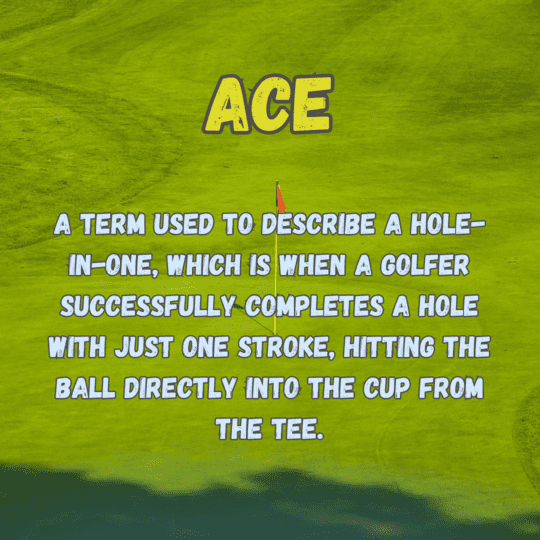
Ace
A term used to describe a hole-in-one, which is when a golfer successfully completes a hole with just one stroke, hitting the ball directly into the cup from the tee.
Address
Refers to the golfer’s stance and positioning in preparation to swing the club. It includes factors such as aligning the body, positioning the feet, and gripping the club.
Albatross
Also known as a “double eagle,” it refers to a score of three strokes under par on a single hole. This rare achievement typically occurs when a golfer completes a par-5 hole with just two shots.
B
Backswing
The initial part of a golf swing where the club is taken back away from the ball. It involves rotating the body, lifting the club, and setting the club on the correct swing plane.
Backspin
The backward rotation of the golf ball caused by the contact with the clubface during a shot. Backspin helps the ball stay in the air longer, aids in controlling distance, and allows for better stopping power on the green.
Back 9
Refers to the second half of an 18-hole golf course, specifically holes 10 through 18. It is called the “back 9” because these holes are typically played after completing the front 9 holes.
Birdie
A score of one stroke under par on a hole. It occurs when a golfer completes a hole in one stroke less than the designated par for that hole.
Blade
A type of golf club with a thin, flat face and minimal forgiveness. Blade clubs are typically used by skilled golfers who prefer maximum control and workability.
Bogey
A score of one stroke over par on a hole. It happens when a golfer completes a hole in one stroke more than the designated par for that hole.
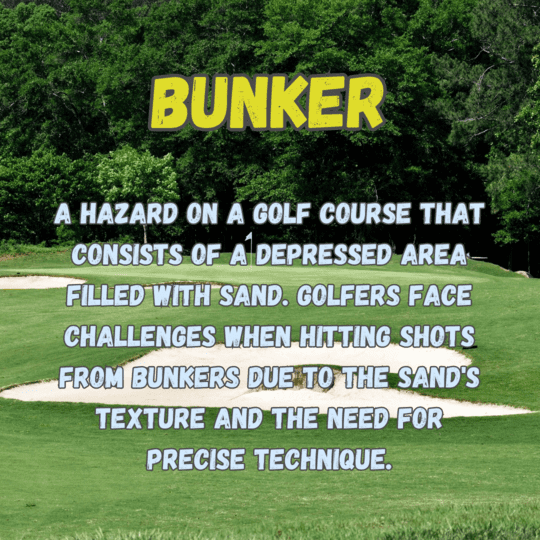
Bunker
A hazard on a golf course that consists of a depressed area filled with sand. Golfers face challenges when hitting shots from bunkers due to the sand’s texture and the need for precise technique.
C
Caddie
A person who carries a golfer’s bag and provides assistance during a round. Caddies often offer advice on club selection, course strategy, and reading greens.
Center Shaft
A type of putter design where the shaft is aligned in the center of the clubhead, typically connecting at the rear or midpoint. This design promotes a balanced stroke and improved alignment.
Cup
Also known as the “hole,” it is the final destination where the golf ball must come to rest. The cup is a circular hole on the putting green and is the target for completing each hole.
D
A type of golf hole design where the fairway bends or curves to the left or right, usually forming an angle. Golfers must strategically navigate dogleg holes to position themselves for an advantageous approach shot.
Dog Lie
A term used to describe a ball that comes to rest in an unfavorable position on the course, such as in a divot, rough, or other challenging area.
Double Eagle
Also known as an “albatross,” it refers to a score of three strokes under par on a single hole. This rare achievement typically occurs when a golfer completes a par-5 hole with just two shots.
Double Bogey
A score of two strokes over par on a hole. It occurs when a golfer completes a hole in two strokes more than the designated par for that hole.
E
Eagle
A score of two strokes under par on a hole. It happens when a golfer completes a hole in two strokes less than the designated par for that hole.
Elevated Green
A putting green that is raised or elevated compared to the surrounding fairway or terrain. Elevated greens often require precision and accurate club selection to approach and putt effectively.
F
Forgiving
A term used to describe golf clubs or golf course features that are more forgiving of off-center or mis-hit shots. Forgiving clubs or courses can help reduce the impact of mistakes and improve overall consistency.
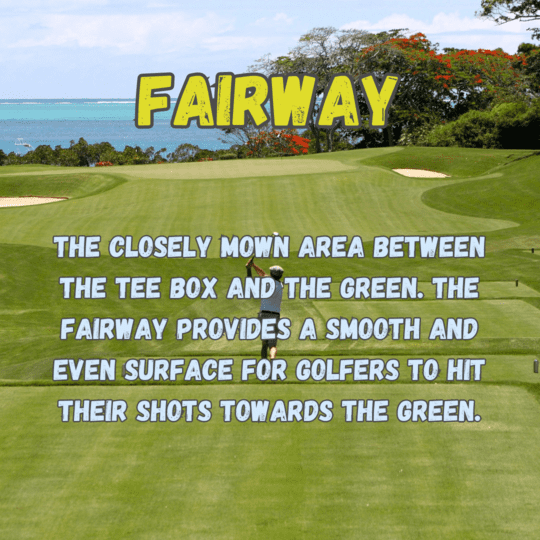
Fairway
The closely mown area between the tee box and the green. The fairway provides a smooth and even surface for golfers to hit their shots towards the green.
Fore
A warning shout used by golfers to alert others of an errant shot heading in their direction. It is a safety precaution to prevent players from being hit by incoming golf balls.
G
Green
The area on a golf hole where the cup is located. It is a specially prepared surface with short grass that is well-maintained for putting.
Green In Regulation
Abbreviated as “GIR,” it refers to hitting the ball onto the putting green within the prescribed number of strokes (par) for that hole. It typically implies reaching the green in two strokes on par-4 holes or in three strokes on par-5 holes.
Green Fee
The fee or charge that golfers pay to play a round of golf on a specific golf course.
H
Handicap
A numerical measure of a golfer’s playing ability, used to level the playing field in competition. It allows golfers of different skill levels to compete fairly by adjusting the number of strokes they receive on certain holes or throughout the round.
L
Long Game
Refers to shots that cover longer distances, typically from the tee to the fairway or from the fairway towards the green.
M
Mulligan
A term used for an unofficial “do-over” shot or extra stroke that is not counted towards the score. It is sometimes allowed in casual play to give golfers another chance after a poor shot.
P
Pace
Refers to the speed at which a round of golf is played. It includes considerations such as maintaining a reasonable pace to avoid slow play and keeping up with the group ahead.
Par
The designated number of strokes that a skilled golfer is expected to complete a hole or a round in. Par values are typically assigned to each hole based on its length and difficulty.
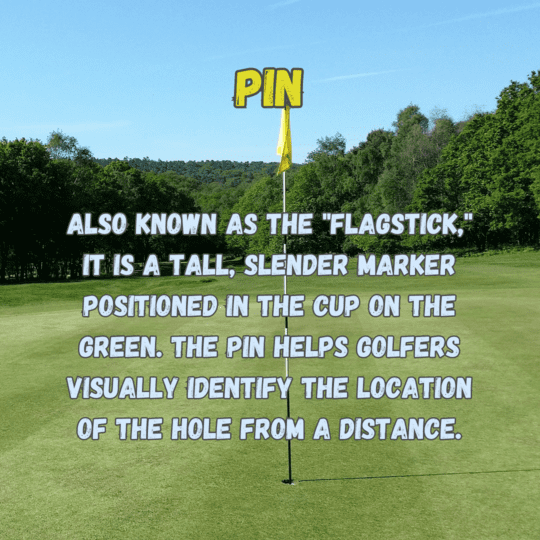
Pin
Also known as the “flagstick,” it is a tall, slender marker positioned in the cup on the green. The pin helps golfers visually identify the location of the hole from a distance.
R
A device used by golfers to measure distances on the golf course accurately. Rangefinders help golfers determine how far they are from various targets, such as the hole or hazards.
S
Short Game
Refers to shots played near or around the green, including chipping, pitching, and putting. The short game is crucial for scoring well and involves finesse, touch, and precision.
Semi-Rough
The area of longer grass located between the fairway and the rough. It provides a moderate level of difficulty compared to the fairway and rough, requiring players to exercise control and accuracy.
Stroke
Refers to a single swing of the golf club that is intended to strike the ball. Each time a golfer attempts to hit the ball, it counts as one stroke.
Stroke Play
A scoring format in golf where each player’s total number of strokes throughout the round is added up to determine the winner. The player with the lowest total score wins.
U
Unplayable
A term used to describe a situation where a golfer deems their ball to be in an unplayable position on the course. In such cases, players can take penalty strokes and declare their ball unplayable to proceed with the next shot from a different location.
Complete List Of all Golf Terms And Slang
Jump To : A B C D E F G H I J K L M N O P Q R S T U V W Y Z
A
Alignment
The process of positioning one’s body and club in relation to the target line, ensuring that the body and clubface are properly aligned for an accurate shot.
Apron
The area of grass or turf immediately surrounding the putting green, also known as the fringe.
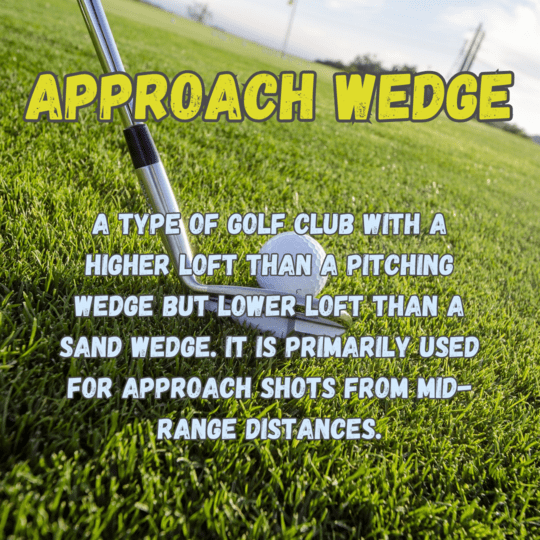
Approach
The shot played with the intent of reaching the putting green, typically from the fairway or rough.
A type of golf club with a higher loft than a pitching wedge but lower loft than a sand wedge. It is primarily used for approach shots from mid-range distances.
Away
A term used to indicate that another player is farther from the hole and should play their shot first.
B
Ball Marker
A small object, often a coin or a marker specifically designed for the purpose, placed on the green to mark the position of a golfer’s ball when it is lifted.
Banana Ball
A shot that curves significantly from left to right (for a right-handed golfer) or right to left (for a left-handed golfer), resembling the shape of a banana.
Bandit
Slang for a golfer who intentionally misrepresents their skill level or handicap, playing at a lower level to gain an advantage in competition.
Baseball Grip
A grip style where the hands are positioned on the club grip similarly to how a baseball player holds a bat, with all ten fingers in contact with the grip.
Below The Hole
Refers to a position on the putting green that is closer to the direction in which the ball will roll towards the hole. Being below the hole generally provides an advantage when putting.
Big Dog
A colloquial term for a driver, which is the club used to hit the ball off the tee on long, open holes.
Bite
The ability of a golf ball to stop quickly or spin back after landing on the green.
Bladed Shot
A shot where the leading edge of the club contacts the ball higher than intended, resulting in a low, skidding trajectory.
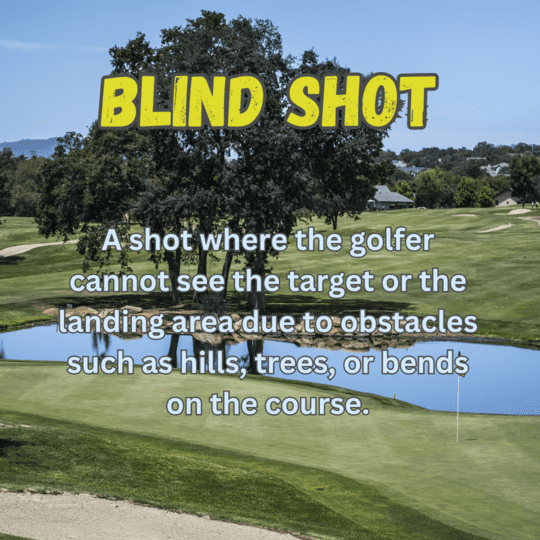
Blind Shot
A shot where the golfer cannot see the target or the landing area due to obstacles such as hills, trees, or bends on the course.
Block
A shot that flies straight to the right (for a right-handed golfer) or left (for a left-handed golfer) of the intended target line without significant curve.
Bounce
The angle or curvature on the sole of a golf club, primarily irons and wedges, which helps the club glide smoothly through the turf and prevents excessive digging.
Bump And Run
A type of shot played around the green where the ball is hit with a low trajectory and allowed to roll along the ground for a significant portion of the shot.
Best Ball
A format of play where multiple players form a team, and each player plays their own ball throughout the round. The team’s score for each hole is the lowest score achieved by any team member.
BOX
An acronym used to describe the area on a scorecard where the player’s score for each hole is recorded.
Break
The curving or bending of a putt caused by the slope or contour of the green.
Burn
A sandy area or waste bunker on a golf course that is not officially considered a hazard but still poses challenges for golfers.
Businessman’s Grip
A term used to describe a grip style where the little finger of the trailing hand (right hand for a right-handed golfer) is extended or positioned away from the club grip.
C
Calcutta
A betting or auction format commonly used in golf tournaments where participants can bid on the players or teams they believe will perform well.

Cat Box
Slang for a sand bunker or sand trap on a golf course.
Carpet
Slang for the putting green, which is often characterized by its smooth and well-manicured surface.
Carry
The distance a golf ball travels through the air before it touches the ground.
Cavity Back
Refers to a design feature found in some irons where the back of the clubhead has a cavity or hollowed-out section. This design redistributes weight to the perimeter of the clubhead, providing forgiveness and stability on off-center hits.
Center Of Gravity
The point within a golf club or golf ball where the majority of the weight is concentrated. The location of the center of gravity affects the club’s performance and the ball’s trajectory.
Chip
A short, low-trajectory shot played with a lofted club, typically near the green, to get the ball onto the putting surface.
Choke Down
The act of gripping the club lower down the grip than usual, effectively reducing the length of the club. It is often done to gain more control or to adjust for a specific shot distance.
Chunk
A mishit shot where the club strikes the ground before contacting the ball, resulting in a loss of distance and a shot that doesn’t travel as intended.
Clone Clubs
Golf clubs that are designed and manufactured to closely resemble the characteristics and specifications of clubs from well-known brands.
Collar Of The Green
The area of grass surrounding the putting green that is slightly higher and thicker than the putting surface itself.
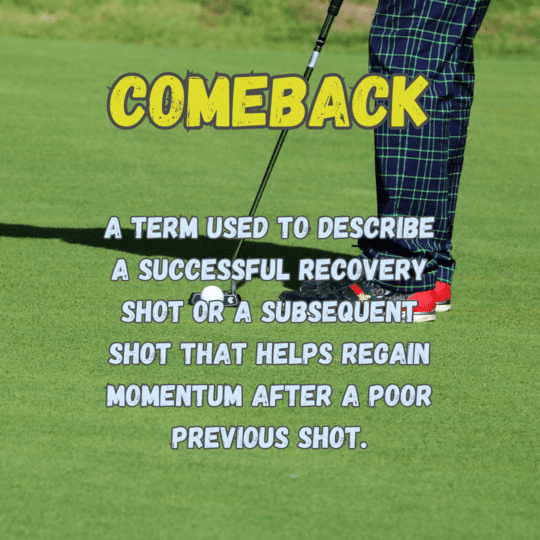
Comeback
A term used to describe a successful recovery shot or a subsequent shot that helps regain momentum after a poor previous shot.
Concede
A courtesy extended in match play where a player or opponent acknowledges that their opponent’s upcoming putt or shot is considered holed or made without requiring them to complete the action.
Condor
The rarest score in golf, achieved by holing out a par-5 hole in one stroke.
Course Rating
A numerical value assigned to a golf course representing the difficulty level of the course for a scratch golfer. The rating takes into account factors such as length, obstacles, and overall challenge.
Covey
Slang for a group of three golfers playing together.
Closed Face
A clubface position where the leading edge of the club is angled slightly towards the golfer, resulting in a shot that tends to curve from right to left (for a right-handed golfer) or left to right (for a left-handed golfer).
Closed Stance
A setup position where the golfer’s front foot is positioned closer to the target line than their back foot, resulting in a stance that is angled slightly towards the target.
Coefficient Of Restitution
Abbreviated as “COR,” it is a measure of the efficiency with which a golf ball rebounds off the clubface upon impact. A higher COR indicates a greater energy transfer and potential for increased distance.
Compression
Refers to the deformation of a golf ball upon impact with the clubface. A higher compression ball requires more force to compress and is typically suited for players with faster swing speeds.
Cut
A controlled shot intentionally played with a left-to-right (for a right-handed golfer) or right-to-left (for a left-handed golfer) curve.
D
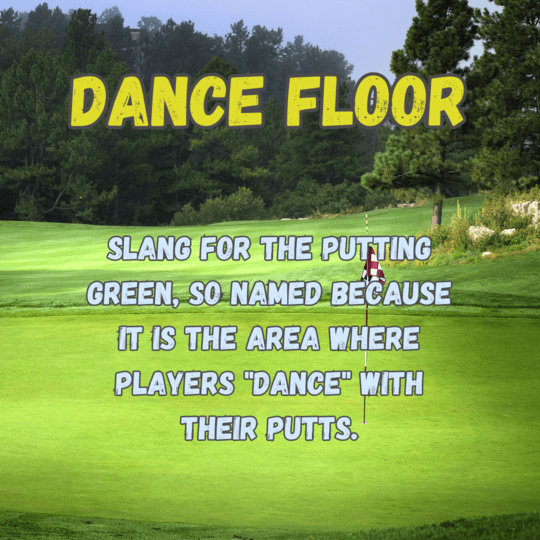
Dance Floor
Slang for the putting green, so named because it is the area where players “dance” with their putts.
De-Loft
The act of decreasing the effective loft of a club at impact by manipulating the hands and wrists. De-lofting a club can result in a lower ball flight and increased distance.
Dimples
The small indentations or depressions on the surface of a golf ball. Dimples help reduce aerodynamic drag and allow the ball to achieve lift and maintain stability during flight.
Divot
A small piece of turf or grass that is displaced when a golf club strikes the ground during a swing.
A shot that curves gently from right to left (for a right-handed golfer) or left to right (for a left-handed golfer).
Duff
A colloquial term for a poorly struck shot where the clubhead makes poor contact with the ball, resulting in a weak, misdirected, or mishit shot.
E
Etiquette
The set of unwritten rules and guidelines that govern proper behavior and respect for others on the golf course.
Even Par
A score equal to the designated par for a golf course, indicating that the player has not gained or lost strokes in relation to the course’s expected difficulty.
F
A shot that curves gently from left to right (for a right-handed golfer) or right to left (for a left-handed golfer).
Fairway Markers
Objects or markers, such as stakes or lines, placed along the sides of the fairway to indicate boundaries or specific distances.
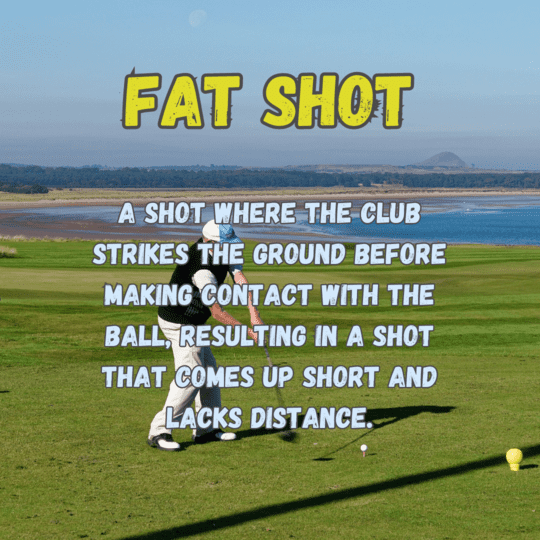
Fat Shot
A shot where the club strikes the ground before making contact with the ball, resulting in a shot that comes up short and lacks distance.
Ferret
Slang for a shot that narrowly avoids a hazard or obstacle, often considered fortunate or lucky.
Flat Stick
Slang for a putter, which is the club used for making strokes on the putting green.
Flex
Refers to the amount of bending or stiffness in a golf shaft. Different flex options, such as regular, stiff, or extra stiff, are available to match a golfer’s swing characteristics and speed.
Flier
A shot where the ball travels farther than expected due to reduced spin caused by grass or other material trapped between the clubface and the ball.
Flight
The trajectory and path the ball takes through the air.
Flop Shot
A high, soft shot played with a high-lofted club, typically around the green, to clear an obstacle and land the ball softly.
Flush Shot
A shot that is struck cleanly and solidly in the center of the clubface, resulting in optimal distance and accuracy.
Follow-Through
The continuation of the golf swing after the clubhead has made contact with the ball. A smooth and balanced follow-through is important for maintaining control and maximizing distance.
Forged Irons
Golf irons that are made by heating and shaping a single piece of metal, resulting in a clubhead with enhanced feel, responsiveness, and workability.
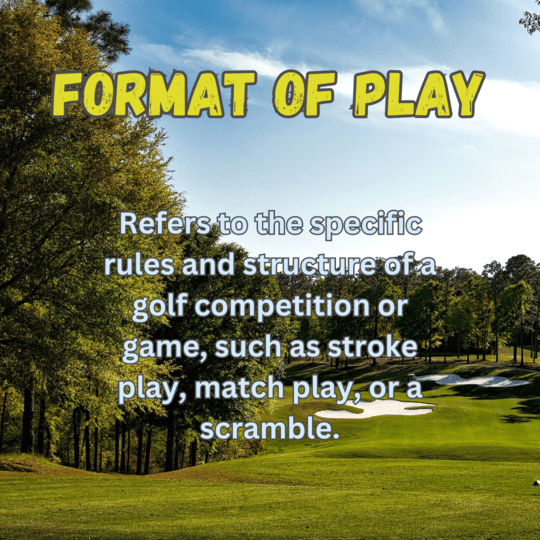
Format Of Play
Refers to the specific rules and structure of a golf competition or game, such as stroke play, match play, or a scramble.
Forward Press
A slight forward movement of the hands towards the target before starting the backswing. It helps promote a more aggressive and dynamic swing.
Four Ball
A format of play where two-player teams compete against each other, with each player playing their own ball. The lowest score for each team on each hole is recorded.
Freshie
Slang for a shot that travels a great distance, often used when describing a particularly long drive.
Fried-Egg Lie
A lie where the ball is partially buried or embedded in a sand bunker, resembling a fried egg in appearance.
Fringe
The outer edge of the putting green where it meets the closely mown area or apron.
Frogged
Slang for a putt that stops right at the edge of the hole but does not drop in.
Front 9
The first nine holes of an 18-hole golf course.
G
A golf club with a loft between a pitching wedge and a sand wedge, typically used for approach shots from distances shorter than a pitching wedge but longer than a sand wedge.
Gimme
An informal agreement among players in casual rounds where a short putt is conceded by opponents without requiring it to be holed.
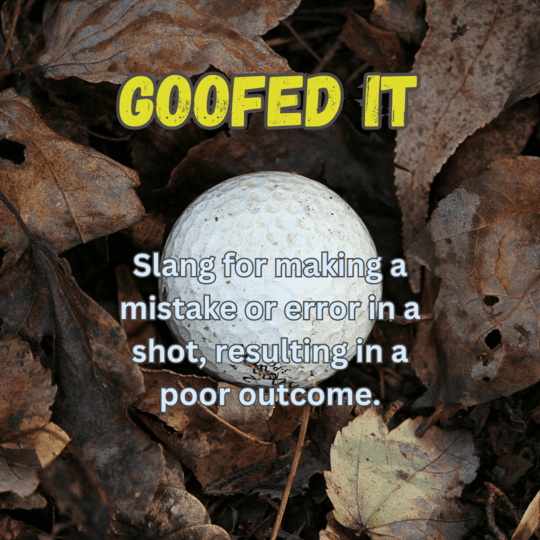
Goofed It
Slang for making a mistake or error in a shot, resulting in a poor outcome.
Grain
The direction and texture of the grass on the putting green, which can affect the roll and break of a putt.
Grip
The way a golfer holds the club, including the positioning and pressure applied by the hands.
Ground Under Repair
Areas on the golf course that are temporarily designated as off-limits or restricted due to maintenance, damage, or other reasons.
Gross Score
The total score of a player or team before any handicap or adjustment is applied.
Grounding The Club
The act of touching the clubhead to the ground before addressing the ball, typically done to ensure stability and alignment.
Grooved
Refers to a consistent and repetitive swing motion that produces consistent results.
Gummed
Slang for a shot where the clubhead strikes the ball with little or no spin, resulting in a shot that doesn’t hold the intended line or stops quickly upon landing.
Guzzler
Slang for a golfer who frequently consumes alcoholic beverages during a round of golf.
H
Hacker
A term used to describe an inexperienced or unskilled golfer, often one who struggles with consistency and technique.
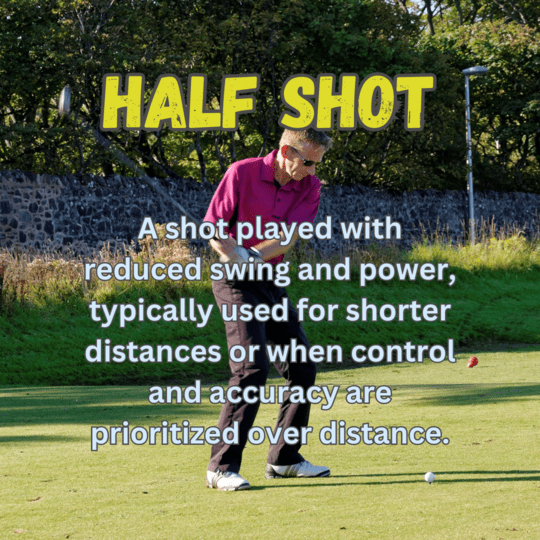
Half Shot
A shot played with reduced swing and power, typically used for shorter distances or when control and accuracy are prioritized over distance.
Halve A Hole
In match play, when both players or teams achieve the same score on a hole, resulting in the hole being considered tied or “halved.”
Hank
Slang for a hole-in-one, also known as an ace.
Hazard
Any area on the golf course, such as a water hazard or bunker, that is designated as a penalty area and poses a challenge or risk for golfers.
Heel
The part of the clubhead closest to the hosel or the area where the shaft connects to the clubhead.
Hole Out
The act of sinking the ball into the hole, typically with a putt.
Home Course
The golf course where a golfer is a member or plays most frequently.
Honors
The privilege of teeing off first on a hole, usually given to the player who had the lowest score on the previous hole.
Hook
A shot that curves sharply from right to left (for a right-handed golfer) or left to right (for a left-handed golfer).
Hosel
The part of the clubhead where the shaft is connected, also known as the club’s neck.

Hustler
A skilled golfer who uses various tactics, such as betting or psychological strategies, to gain an advantage over opponents.
Hybrid
A type of golf club that combines the characteristics of both irons and woods, typically designed to be more forgiving and easier to hit than long irons.
I
Impact
The moment when the clubhead makes contact with the ball during a swing.
Interlocking Grip
A grip style where the little finger of the trailing hand (right hand for a right-handed golfer) is interlocked with the index finger of the lead hand (left hand for a right-handed golfer).
In The Teeth
Slang for hitting the ball directly into the wind, resulting in a challenging shot that requires extra power and control.
J
Jerked The Putt
Slang for making a sudden and abrupt movement during a putting stroke, often resulting in a misdirection or mishit putt.
K
Kick Point
The specific location on a golf shaft where it is designed to flex most during the swing, influencing the launch angle and trajectory of the ball.
Knock Down Shot
A controlled shot played with a reduced trajectory, typically used to keep the ball under the wind or to hit a controlled approach shot.
L
Lag Putt
A long putt played with the intention of getting the ball close to the hole while minimizing the risk of three-putting.
Lay-Up
A strategic shot played with the intention of purposely hitting the ball short of a hazard or obstacle, setting up a more manageable next shot.
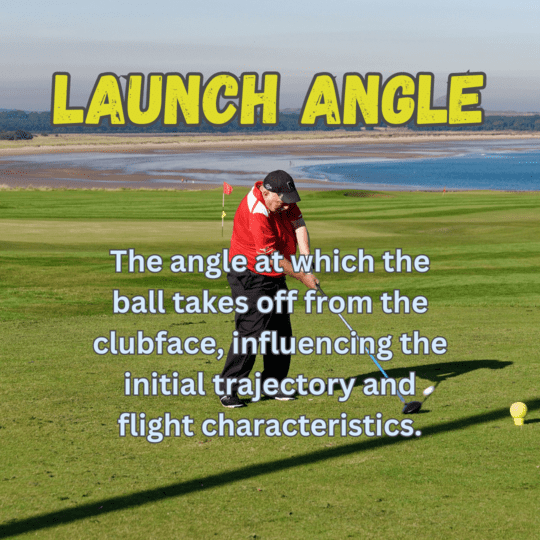
The angle at which the ball takes off from the clubface, influencing the initial trajectory and flight characteristics.
Leak
A shot that curves unintentionally to the right (for a right-handed golfer) or left (for a left-handed golfer), often resulting from a swing path that is slightly “over the top.”
Level-Par
A score equal to the designated par for a golf course, indicating that the player has not gained or lost strokes in relation to the course’s expected difficulty.
Lie
Refers to the position and angle at which the ball rests on the ground or in a specific area of the golf course.
Line
The intended path or direction that a golfer aims for when playing a shot.
Links
A type of golf course that is built on seaside or coastal terrain, characterized by sandy soil, dunes, and natural grasses.
Lip
The raised edge of a bunker or hazard that surrounds the opening.
Local Rule
Additional rules specific to a particular golf course or tournament that are implemented to address unique situations or conditions.
Long
Refers to a putt or shot that travels a significant distance, often used to describe a long drive or approach shot.
A high-lofted wedge club, typically with a loft greater than 58 degrees, used for hitting high shots with a steep trajectory.
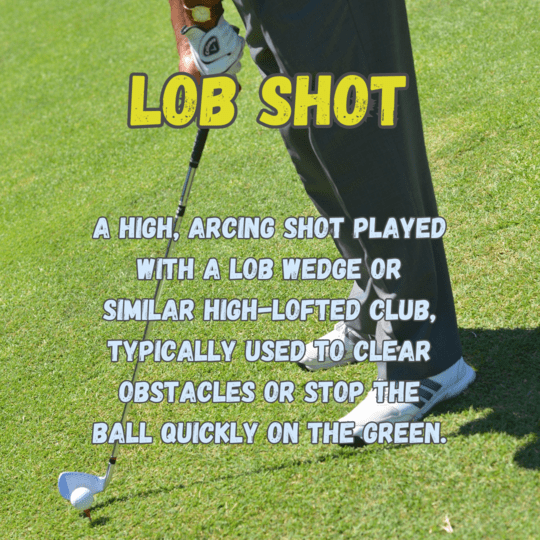
Lob Shot
A high, arcing shot played with a lob wedge or similar high-lofted club, typically used to clear obstacles or stop the ball quickly on the green.
Loft
The angle of the clubface that determines the launch angle and trajectory of the ball.
Low Handicapper
A golfer with a low handicap, indicating a higher skill level and ability to consistently shoot lower scores.
M
Make The Cut
In professional golf tournaments with multiple rounds, to make the cut means to achieve a score that allows the player to continue competing in the subsequent rounds.
Mallet Putter
A type of putter with a larger, more substantial clubhead shape, often featuring a larger alignment aid or face insert for improved stability and forgiveness.
Major
Refers to one of the four prestigious and highly regarded professional golf tournaments: the Masters Tournament, the U.S. Open, The Open Championship (British Open), and the PGA Championship.
Match Play
A format of golf where players or teams compete against each other on a hole-by-hole basis, with each hole representing a separate contest.
Marker
A small object, such as a coin or ball marker, used to indicate the position of the ball on the green or to mark the scorecard.
MDF
Abbreviation for “Made Cut, Didn’t Finish.” In professional golf tournaments, MDF refers to a cut made after the second round when the number of players who qualify for the final rounds exceeds a specified limit, and additional cuts are made after the third round.
N
Nassau Golf
A popular golf betting game that consists of three separate bets: the front nine, the back nine, and the overall 18-hole score.
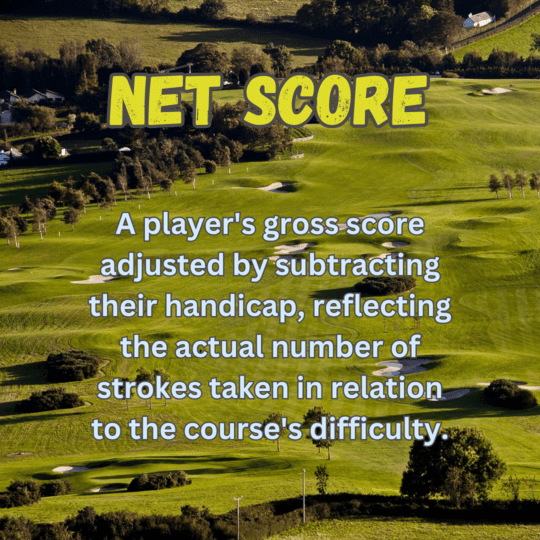
Net Score
A player’s gross score adjusted by subtracting their handicap, reflecting the actual number of strokes taken in relation to the course’s difficulty.
O
OB
Abbreviation for “Out of Bounds,” referring to areas on the golf course where a ball is considered to be outside the playable boundaries and incurs a penalty.
One-Piece Takeaway
Refers to a unified and connected movement of the arms, hands, and shoulders during the initial phase of the backswing.
On The Charge
Slang for playing exceptionally well and making a strong surge or comeback during a round.
Offset
A design feature found on some golf clubs where the leading edge of the clubface is set back slightly behind the hosel, helping to promote a square clubface at impact and reduce the tendency to slice.
Open Face
Refers to a clubface that is rotated or pointing more to the right (for a right-handed golfer) or left (for a left-handed golfer) than the target at address or impact, potentially leading to shots that curve to the right or left.
Open Stance
A stance in which a golfer’s feet are positioned more to the left (for a right-handed golfer) or right (for a left-handed golfer) of the target line.
Open The Face
The act of rotating the clubface more open or to the right (for a right-handed golfer) or left (for a left-handed golfer) at address or during the swing.
Out-Of-Bounds
Areas outside the playable boundaries of the golf course where a ball is considered to be out-of-play and incurs a penalty.
Oversize Grip
A larger-diameter grip on a golf club, designed to provide increased stability and reduce excessive hand and wrist movement during the swing.
P
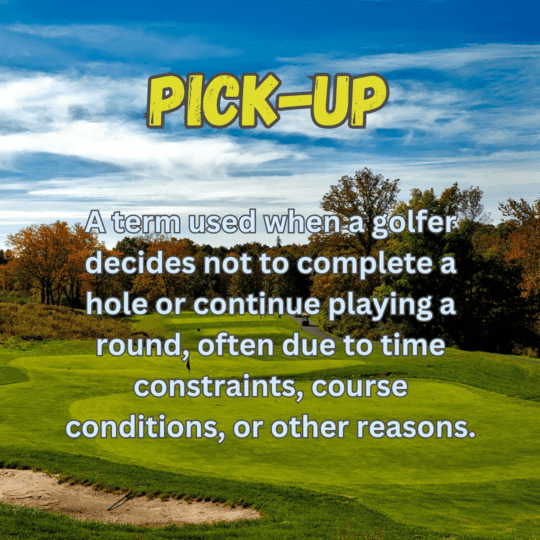
Pick-Up
A term used when a golfer decides not to complete a hole or continue playing a round, often due to time constraints, course conditions, or other reasons.
Pin High
Refers to the position of a ball on the green that is level with the hole but not past it, indicating that the ball has reached the same distance as the hole.
Pitch Shot
A short shot played with a high-lofted club, typically used to cover a relatively short distance with a high trajectory.
Pitch Mark
A small indentation or mark left on the green by the ball when it lands on the surface.
Pick Up Your Lipstick
Slang for retrieving the ball from the hole after holing out.
Play Through
When a faster group of golfers is allowed to pass a slower group by moving ahead and continuing their play.
Plugged Lie
A lie where the ball is partially or completely buried in the ground, often in a bunker or in wet soil, making it challenging to make clean contact with the ball.
Pot
Slang for sinking a putt.
Press
A side bet or additional wager made during a round of golf, often initiated by a player or team that is trailing in the match.
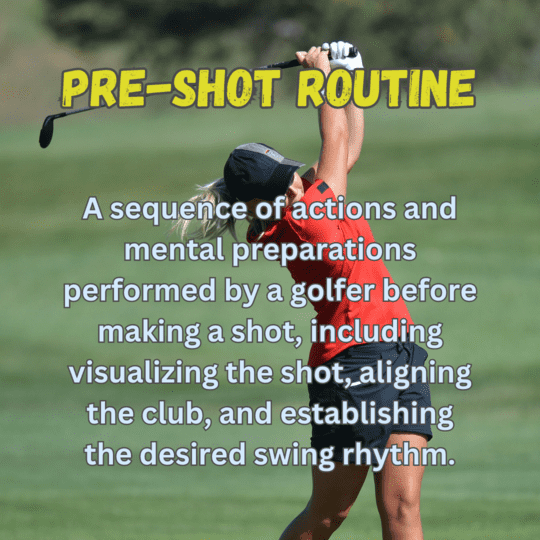
Pre-Shot Routine
A sequence of actions and mental preparations performed by a golfer before making a shot, including visualizing the shot, aligning the club, and establishing the desired swing rhythm.
Provisional Shot
A shot played when there is a possibility that the original ball may be lost or out-of-bounds. The provisional shot is played as insurance, allowing the player to continue play without returning to the original position if the original ball cannot be found.
Pull
A shot that curves to the left (for a right-handed golfer) or right (for a left-handed golfer), often caused by a swing path that is slightly “inside-out.”
Push
A shot that flies to the right (for a right-handed golfer) or left (for a left-handed golfer), typically caused by a swing path that is slightly “outside-in.”
Punch Shot
A low-trajectory shot played with a shorter backswing and a more controlled follow-through, often used to navigate under or around obstacles or to combat strong winds.
Putt
A stroke made on the putting green with the intention of rolling the ball into the hole.
Q
Q-School
Abbreviation for “Qualifying School,” a series of tournaments and qualifying stages held by professional golf tours to determine eligibility and ranking for players seeking tour membership.
R
Reading The Green
The process of assessing the slope, grain, and other factors on the green to determine the line and speed of a putt.
Recovery
A shot or series of shots played from a difficult or unfavorable position, often aimed at regaining control and advancing the ball toward the intended target.
Release
The natural rotation and unhinging of the wrists and forearms during the downswing and impact, allowing the clubhead to square up and strike the ball with power.
Re-Load
Slang for hitting a second shot immediately after a poor shot, typically due to a lack of focus or frustration.
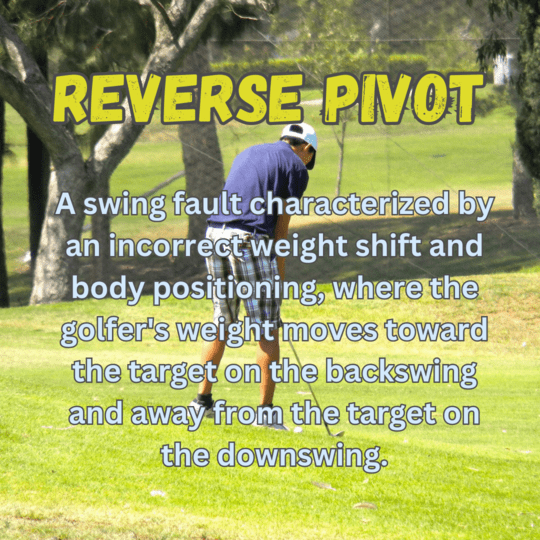
Reverse Pivot
A swing fault characterized by an incorrect weight shift and body positioning, where the golfer’s weight moves toward the target on the backswing and away from the target on the downswing.
Rhythm
The smooth and consistent tempo and timing of a golfer’s swing, often associated with a balanced and controlled motion.
Rough
The longer grass areas surrounding the fairways and greens, often penalizing shots that land in it by making it more difficult to control distance and accuracy.
Run
The distance a ball travels along the ground after landing, typically used to describe shots with lower trajectories and less backspin.
S
A lofted wedge club with a higher degree of loft than a pitching wedge, designed for hitting shots out of bunkers or other sandy areas.
A format of play, often used in casual or team golf events, where all players hit their own shots and then select the best shot among them. All players then play their next shot from that chosen position.
Scratch
A term used to describe a golfer with a handicap index of zero, indicating that they are capable of shooting par or better on a consistent basis.
Schlaffed
Slang for hitting the ball with a poor or weak swing, resulting in a shot that lacks power or distance.
Setup
The positioning and alignment of a golfer’s body and club at address, including the placement of the feet, hips, shoulders, and clubface.
Shank
A shot where the ball is struck with the hosel of the club, resulting in a severe veer to the right (for a right-handed golfer) or left (for a left-handed golfer).
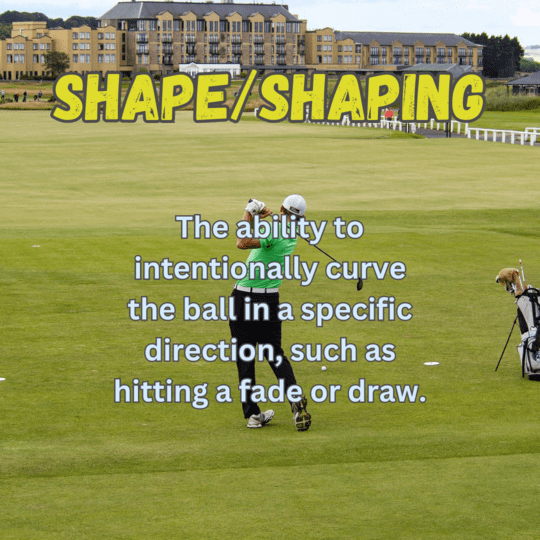
The ability to intentionally curve the ball in a specific direction, such as hitting a fade or draw.
Shaft Weight
The mass or heaviness of the shaft of a golf club, which can influence the feel, control, and swing characteristics.
Short
Refers to a shot or putt that does not travel the desired or expected distance.
A format of starting a golf tournament where groups of players begin play simultaneously from different holes on the course, with each group starting on a different hole.
Shot Making
The ability to control the flight, trajectory, and shape of the ball, often achieved through adjustments in swing technique, club selection, and shot strategy.
Sink A Putt
To successfully make a putt, resulting in the ball falling into the hole.
Skied
Slang for hitting a shot with the driver or fairway wood that results in the ball launching high into the air but traveling a relatively short distance.
Slice
A shot that curves sharply from left to right (for a right-handed golfer) or right to left (for a left-handed golfer).
Slider
A shot that curves gently from one side to the other, typically used to describe a controlled fade or draw.
Slope Rating
A numerical value assigned to a golf course, indicating the relative difficulty of the course for a scratch golfer compared to a bogey golfer.
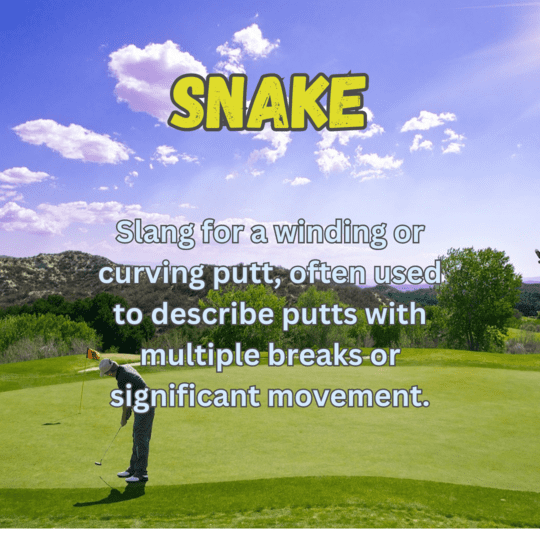
Snake
Slang for a winding or curving putt, often used to describe putts with multiple breaks or significant movement.
Slang for a score of 8 on a hole, reflecting the shape of the number “8.”
Sole
The bottom surface of a golf club, which comes into contact with the ground during the swing.
Spoon
An old-fashioned term for a wood club, typically referring to a club with a higher loft, such as a 3-wood or 4-wood.
Square
Refers to the alignment of the clubface at impact, when it is positioned perpendicular to the target line.
Squirt
Slang for a shot that veers unexpectedly off-target or off-line.
Stableford
A scoring system used in some golf competitions, where points are awarded based on the number of strokes taken on each hole relative to a predetermined score.
Stance
The position and placement of a golfer’s feet and body in relation to the target line and ball at address.
Still Yours
A phrase used to indicate that a player’s ball is still away or farthest from the hole and that it is not yet their turn to play.
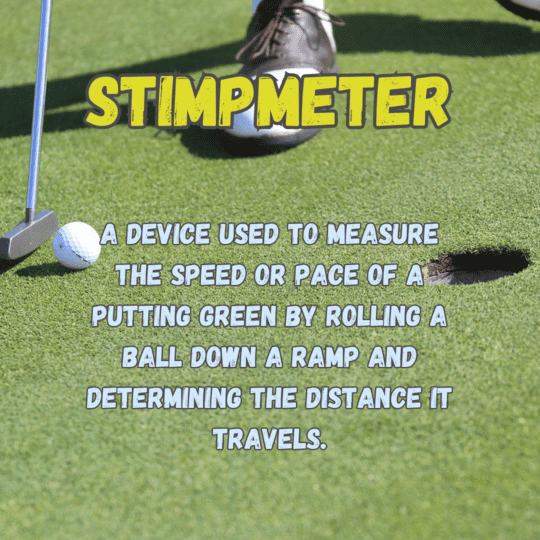
Stimpmeter
A device used to measure the speed or pace of a putting green by rolling a ball down a ramp and determining the distance it travels.
Strong Grip
A grip position on the club where the hands are rotated more to the right (for a right-handed golfer) or left (for a left-handed golfer), often promoting a closed clubface at impact.
Swale
A low-lying area on a golf course with a gentle slope, often influencing the movement and break of putts.
Sweet Spot
The area on the clubface that is considered the optimal point of contact for maximum distance, accuracy, and feel.
The motion or action of the golfer as they strike the ball, encompassing the backswing, downswing, and follow-through.
Swing Plane
The imaginary inclined plane or path that the clubhead follows during the swing, often defined by the angle and alignment of the clubshaft.
T
Takeaway
The initial movement of the club away from the ball during the backswing.
Target Line
The imaginary line extending from the ball to the intended target or desired landing area.
Tap In
A short and easy putt that requires minimal effort to hole out.
Temperature
The ambient air temperature and its potential effect on the distance and performance of the ball.
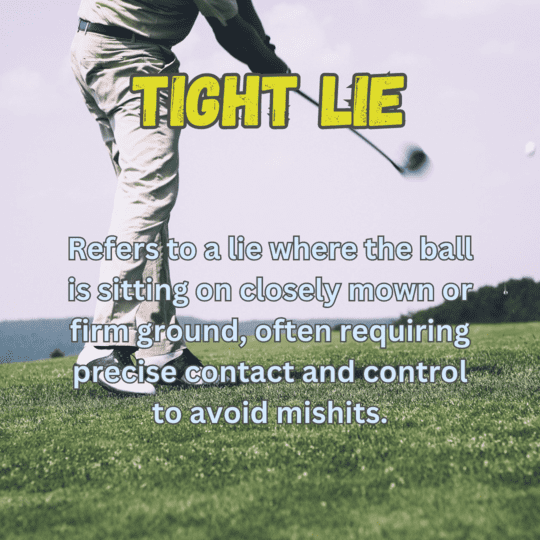
Tight Lie
Refers to a lie where the ball is sitting on closely mown or firm ground, often requiring precise contact and control to avoid mishits.
Thin Shot
A shot where the clubhead strikes the upper half or equator of the ball, resulting in a low, skimming trajectory with reduced spin.
Touch
The delicate and precise control of distance, feel, and finesse required for successful putting and short game shots.
Tending The Pin
The act of removing the flagstick from the hole or holding it up to allow a player to see the hole while putting.
Tee Box
The designated area on each hole from where golfers start their play by teeing up the ball.
Tempo
The speed, rhythm, and timing of a golfer’s swing, often associated with a smooth and consistent motion.
Texas Wedge
The act of using a putter or other low-lofted club to hit a chip or pitch shot from off the green.
The Knife
Slang for a 1-iron club, known for its low loft and difficult-to-hit nature.
The Knife’s Cousin
Slang for a 2-iron club, also known for its low loft and challenging playability.
Toed Shot
A shot where the ball is struck with the toe area of the clubhead, often resulting in a shot that lacks power or accuracy.
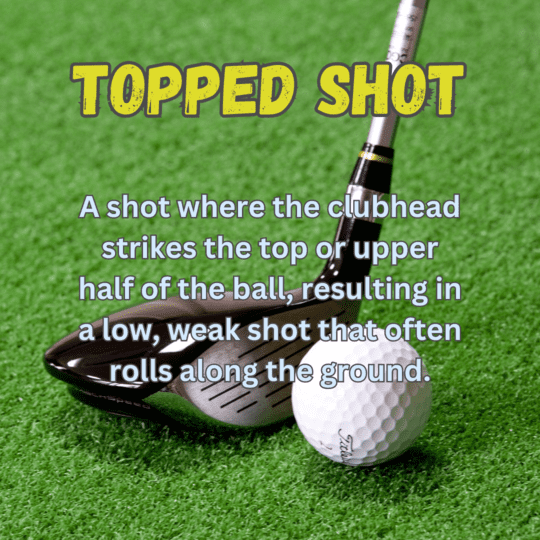
Topped Shot
A shot where the clubhead strikes the top or upper half of the ball, resulting in a low, weak shot that often rolls along the ground.
Trajectory
The flight path or curve of the ball through the air, determined by factors such as loft, clubhead speed, angle of attack, and wind conditions.
Triple Bogey
A score of three strokes over par on a hole.
Turkey
Slang for achieving three consecutive birdies (or better) on three consecutive holes.
U
Unlock
To release tension or stiffness in the body or swing, allowing for a freer and more fluid motion.
Unit
Slang for a round of golf, referring to the completion of all 18 holes.
Up And Down
The successful completion of a hole with just two strokes when starting from off the green, typically involving a chip or pitch shot followed by a single putt.
V
Vardon Grip
A popular grip style in golf where the pinkie finger of the trailing hand overlaps the index and middle fingers of the lead hand.
W
Waggle
A small and rhythmic motion or vibration of the clubhead just above the ball, often performed before initiating the swing to promote relaxation and establish a smooth tempo.
Weak Grip
A grip position on the club where the hands are rotated more to the left (for a right-handed golfer) or right (for a left-handed golfer), often promoting an open clubface at impact.
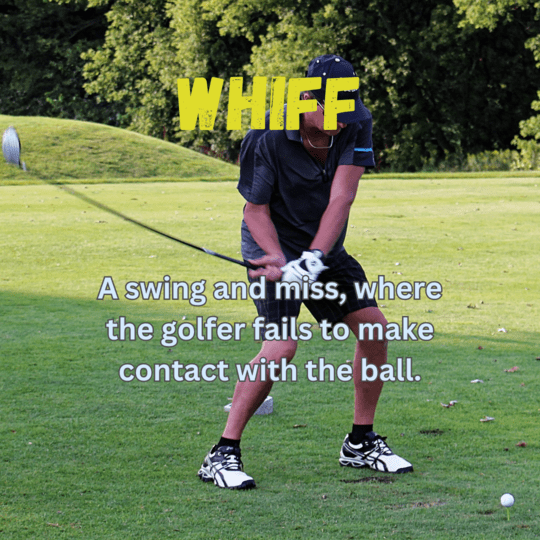
Whiff
A swing and miss, where the golfer fails to make contact with the ball.
Whippy
Referring to a club or shaft that has a flexible or soft feel, often providing increased speed and whip-like action during the swing.
Wire-To-Wire
A term used when a golfer leads a tournament from start to finish, maintaining the lead throughout all rounds.
Y
Yardage Marker
A marker or sign on the golf course that indicates the distance to certain points or hazards, often measured in yards.
Yips
A psychological condition characterized by involuntary and uncontrolled muscle spasms or jerks during putting or short game shots, often resulting in a loss of control and accuracy.
Z
Zinger
Slang for a powerful and impressive shot, often used to describe long drives or approach shots.
Zip
The term in golf used to describe the spin of a golf ball after landing.
